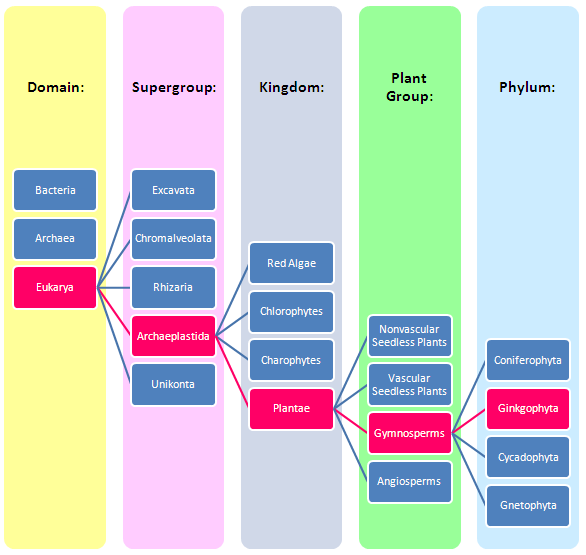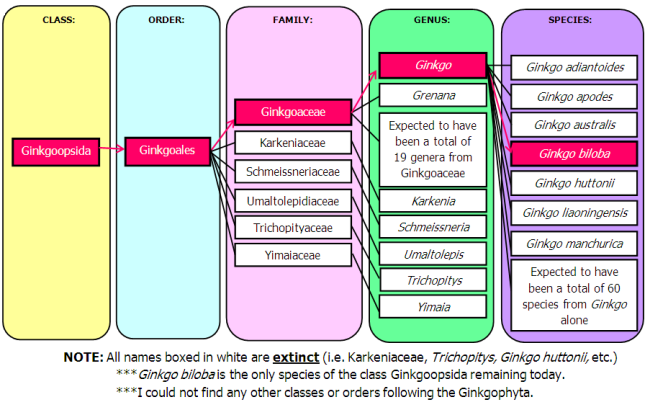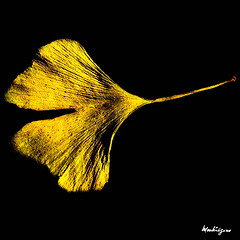Family Tree

*
Table to the left shows classifications for Ginkgo biloba.
Descriptions of each classification are listed below.
Domain: Eukarya
The organism Ginkgo biloba belongs in the domain called Eukarya.
The prefix “eu-“ means “true” and “-karya” means “nucleus.” Therefore,
Ginkgo biloba has a true nucleus (complete with genetic
material) and membrane bound organelles. (Another example of an organism
that is a eukaryote is the
Damselfly.)
Kingdom: Plantae
Kingdom Plantae is a group of multicellular, mostly photosynthetic organisms
that are sessile. The word “plant” comes from the Latin word “plantae.”
(An example of a plant, other than the Ginkgo tree, is
Aloe Vera.)
Phylum: Ginkgophyta
Ginkgophyta is a phylum used to describe seed-bearing or
pollen-bearing deciduous plants that lack flowers and fruiting
structures. Also, the plants are usually dioecious and still have
flagellated sperm cells. It is believed that the Ginkgophytes provide a
link from the Pterophytes (seedless, vascular plants) to the Anthophyta
(flowering plants).

*Figure 1 (above) shows the classification for Ginkgo biloba
from domain to phylum based on molecular and morphological data.
Class: Ginkgoopsida
The Class Ginkgoopsida refers to plants from the Phylum Ginkgophyta that have either strap-shaped or fan-shaped leaves (GLOSSARY). These plants are also dioecious,
having
the XX or XY chromosomes on different plants making each Ginkgo
tree male or female.
Order: Ginkgoales
Scientists are having a very hard time finding information specifically
related to the Order Ginkgoales because they can only do research on the
one species remaining (Ginkgo biloba) or on fossil records. Fossil records
are proving to be hard to distinguish certain characteristics about this
exact order because they are about 200 million years old. The species of Ginkgoales are usually very diverse, making it hard to classify them as
well. Click
HERE to visit a superb online journal article
regarding more in-depth details of the dispute surrounding the Order Ginkgoales.

*Diagram above depicts the classification for Ginkgo biloba
from class to species.
Family: Ginkgoaceae
In order to be part of the Family Ginkgoaceae, the plant(s) in
question typically exhibits dichotomous veins, or veins that branch by
dividing into two equal parts. Also, the pollen is usually produced in a
stamen-like structure, and the outer covering on the seeds (produced by
the female plant) have a putrid smell.
Genus: Ginkgo

Some characteristics that define the genus Ginkgo are
broad (typically triangularly shaped) leaves and the seeds are produced
on the end of a shoot. The leaves of the genus Ginkgo are
usually found coming out of the short shoot and the short shoots are
branched from the longer shoots.
Species: Ginkgo biloba
The specific species Ginkgo biloba is most commonly
characterized by the appearance of its leaves. It wasn’t until 1771 that
the species was defined as “biloba” by Linnaeus; bi-
meaning two, and loba- meaning lobes. The Ginkgo tree is
sometimes termed Ginkgo biloba L. or Ginkgo biloba
Linnaeus, in reference to the scientist who defined the leaves.
 *Reference
the picture on left to see what scientists mean when they say "biloba" or "two lobes."
*Reference
the picture on left to see what scientists mean when they say "biloba" or "two lobes."
Ginkgo biloba not only has a unique classification, but
also it has a one-of-a-kind HISTORY!
HOME
